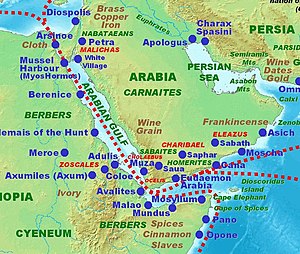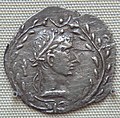Charibael

Charibael (
Name
The two
shared by numerous other South Arabian rulers.Description

The Periplus calls Charibael the "lawful king" of the "Homerites" and "those living next to them called the Sabaites".
He is also probably
Identification


Since
See also
References
Citations
- ^ a b c Glaser (1895), pp. 37–8.
- ^ a b c Shitomi (1976), p. 23.
- ^ a b Robin (1991), p. 12.
- ^ McClure & al. (1897), pp. 84–5.
- ^ Beeston & al. (1982), p. 79.
- ^ Beeston & al. (1982), p. 78.
- ^ Robin (1991), p. 9.
- ^ Schoff (1912), p. 294.
- ^ a b c d e Schoff (1912), p. 107.
- ^ a b Periplus, §23.
- ^ Periplus, §21.
- ^ Schoff (1912), p. 106.
- ^ Periplus, §22.
- ^ Periplus, §24.
- ^ Periplus, §25.
- ^ a b Periplus, §26.
- ^ a b c Periplus, §27.
- ^ Periplus, §33.
- ^ Periplus, §31.
- ^ Periplus, §16.
- ^ a b c Schoff (1912), pp. 115–6.
- ^ a b c Schoff (1912), p. 115.
- ^ Müller (1855).
- ^ Dittrich (1883).
- ^ McLaughlin (2014).
- Geogr., XVI, §§22–24.
- ^ Pliny, Nat. Hist., VI, §32.
- ^ Forster (1844), pp. 314–15.
- ^ Ryckmans (1953).
- ^ Eggermont (1968).
- ^ McLaughlin (2007), p. 7.
- ^ Robin (1997), p. 91.
Bibliography
- – via Wikisource.
- Beeston, Alfred Felix Landon; et al. (1982), Sabaic Dictionary, Beirut: Lebanese Library.
- Dittrich, Heinrich Theodor, under the pseudonym B. Fabricius (1883), Der Periplus des Erythräischen Meeres von einem Unbekannten (in Greek), Leipzig: Veit & Co. & (in German)
- Eggermont, Pierre Herman Leonard (1968), "The Date of the Periplus Maris Erythraei", Papers on the Date of Kaniṣka Submitted to the Conference on the Date of Kaniṣka, London, 20–22 April, 1960, Oriental Monograph Series, vol. IV, Leiden: Brill, pp. 94–96.
- Forster, Charles (1844), The Historical Geography of Arabia, vol. II, London: Duncan & Malcolm.
- Glaser, Eduard (1895), Die Abessinier in Arabien und Afrika, Munich: Hermann Lukaschik. (in German)
- Hommel, Fritz (1897), McClure, Edmund; et al. (eds.), The Ancient Hebrew Tradition as Illustrated by the Monuments, New York: E. & J.B. Young & Co.
- McLaughlin, Daniel (2007), Yemen, Chalfont St Peter: Bradt Travel Guides, ISBN 9781841622125.
- McLaughlin, Raoul (2014), The Romen Empire and the Indian Ocean: The Ancient World Economy & the Kingdoms of Africa, Arabia, & India, Barnsley: Pen & Sword Military, ISBN 9781783463817.
- Müller, Karl, as Carolus Mullerus (1855), "Anonymi Periplus Maris Erythraei", Geographi Graeci Minores, vol. I, Paris: Ambrose Firmin Didot, pp. xcv–cxi & 257–305. (in Greek) & (in Latin)
- Robin, Christian (1991), "L'Arabie du Sud et la Date du Périple de la Mer Érythrée (Nouvelles Données)" (PDF), Journal Asiatique, vol. CCLXXIX, pp. 1–30. (in French)
- Robin, Christian (1997), "Al-Sawdāʾ", Encyclopedia of Islam, vol. IX (2nd ed.), Leiden: Brill, pp. 90–92.
- Ryckmans, Jacques (1953), "La Chronologie Sud-Arabe du Premier Siècle avant Notre Ère", Bibliotheca Orientalis, vol. X, pp. 205–211. (in French)
- Schoff, Wilfred Harvey, ed. (1912), Periplus of the Erythraean Sea, Philadelphia: Commercial Museum.
- Shitomi, Yūzō (1976), "On the Date of Composition of the Periplus Maris Erythraei: A Study of the South Arabian Epigraphic Evidence", Memoirs of the Research Department of the Toyo Bunko, vol. 34, pp. 15–45.
